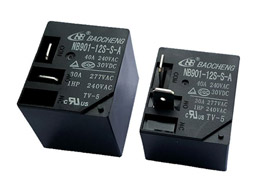Do you know the composition of the relay?
In a broad sense, all components with the ability to automatically complete the relay characteristics are called relays. The parameters of the electromagnetic relay, input and output circuits are all electrical parameters. X is the relay coil current value or voltage value. Y is the current value of the Relay contact loop. Relay consists of three parts.
19F Relay
Reaction mechanism: accepts an input signal and transforms the signal into a physical quantity that causes the relay to operate. For example, the electromagnetic system of an electromagnetic relay.
Intermediary: Provides a standard comparison of controls. For example: 19F Relay's reaction spring or reed.
Actuator: Change the electrical parameters of the output loop. For example: the contact system of the relay (or the part of the contact). Therefore, the relay is an electrical component that reacts and transmits signals.
As a Relay Electronics Manufacturer, what are the factors that affect the reliability of relays?
1. The impact of the environment on the reliability of the relay: The average fault interval of the relay working under GB and SF is the highest, reaching 820,000h, while in the NU environment, it is only 60000h.
2. Influence of quality level on relay reliability: When A1 quality grade relay is selected, the average fault interval can reach 3660000h, and the average fault interval of relays with C grade is 110000, the difference between them is 33 times, the quality of relay can be seen. Level has a great influence on its reliability
3. The influence of the contact form on the reliability of the relay: The contact form of the relay also affects its reliability. The reliability of the single-throw type relay is higher than that of the same number of double-throw type relays. The increase in reliability is gradually reduced, and the average time between failures of single-pole single-throw relays is 5.5 times that of four-pole double-throw relays.
4. Influence of structure type on relay reliability: There are 24 types of relay structures, and different types have an impact on their reliability.
5. The effect of temperature on relay reliability: The operating temperature range of the relay is between -25 and 70 °C. As the temperature increases, the average fault interval of the relay gradually decreases.
6. The effect of the action rate on the reliability of the relay: With the increase of the relay action rate, the average fault interval time is basically exponentially decreasing. Therefore, if the designed circuit requires the relay to operate at a very high rate, then the relay needs to be carefully checked during circuit maintenance in order to replace it in time.
7. Effect of current ratio on relay reliability: The so-called current ratio is the ratio of the working current of the relay to the rated load current. The current ratio has a great influence on the reliability of the relay. Especially when the current ratio is greater than 0.1, the average fault interval decreases rapidly. When the current ratio is less than 0.1, the average fault interval is basically unchanged. Therefore, the rated current should be selected in the circuit design. Larger load to reduce the current ratio, which ensures that the relay and even the entire circuit are not degraded due to fluctuations in operating current.
Our company also has Telecom Relay on sale, welcome to come to consult.


评论
发表评论